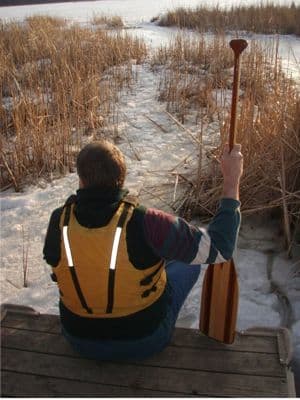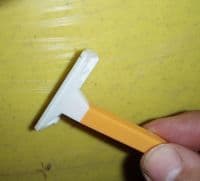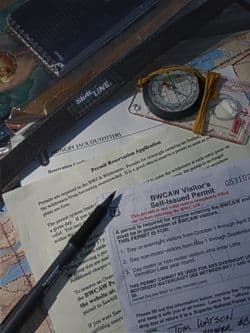Winter Readiness
By Tom Watson
As I watched the National Weather Channel the other night, I scanned the coasts and larger inner waterways across our nation, trying to imagine who was still out there able to paddle as we entered a new year. For a northern boy, temps in the 50’s and 60’s seemed ideal for a romp in the ocean along our more southern coastlines. Then I remembered how fifty degrees feels to someone used to temperatures and humidity in the nineties throughout summer. Maybe there are more of us with kayak-cabin fever than I realized.

Keeping active during the paddle-less months of winter means diversifying one’s activities while keeping a focus on paddling in general. There are many areas in which you can keep the bug alive while sitting out frozen waterways and biting wind chills. Here are a few of the areas related to kayaking and canoeing that can keep you actively engaged in the sport between seasons.
Repairs and maintenance
So often we make repairs in the field that will enable us to at least complete the journey. There’s always tomorrow when it comes to making those major, long-term repairs to your boat. Aside from major repairs that require resins and hardeners that, in turn, require minimum curing temperatures, most fixes in the field can be re-addressed during our off season. Frayed cables, bent rudder blades, sticky foot pedals, re-adjusted thigh braces, stuck seat latches – you name it, winter is a great time to make sure repairs are made. More importantly, since prevention rather than cure is usually always the preferred option, a thorough fix in the winter means fewer breakdowns during the height of paddling pleasure.
Maintenance on some surfaces may mean a simple "shaving" of a rotomold hull. It might mean small surface area reinforcing or it may simply mean a good cleaning and refinish application. A heated garage or area to work makes this option viable; otherwise make it one of the last things to do before hitting the water again.

Lines and deck cleats may need to be replaced or you may want to add a length or two to existing lines. Don’t forget broken or missing clips on PFD and other things, either. When buying replacement parts for your repair session, add one or two and put them in your repair kit you will be making for next summer.
Some times "maintenance" simply means replacing old or worn parts with new hardware. That goes for batteries, too. You may not want to place new batteries in gear just to sit dormant over winter, but tossing the old ones will give you an idea of how many you need to replace and bring you that much closer to being ready in the spring.
How many of you cheat on your survival gear and nibble away at that power chocolate bar on beach stops? Even if you don’t touch your inventory, stuff goes bad. Moist things dry out, dry things get soggy, brittle things moosh out and globby goods lock up like snow after an avalanche. Again, you may want to wait until spring to actually replenish such goods, but early inventories can save time later.
Research
A fancy term merely suggesting taking time over the course of the next few months to catch up on some reading. You know you are a book junky when it comes to new books on kayaking and canoeing. Look at that stack of magazines that have been thumbed through but never actually consumed. I have a stack easily 15” high of magazines I need to read this winter. I’ve dog-eared those articles I am interested in reading but the stack grows with each delivery of mail.
I’ve gathered quite a resource library as well. Those don’t need to be read cover to cover, but its good to remind your self of content and scope of topics for future reference. The sea novels and other books about kayaking adventures are fantastic entertainment during a cold winter night as well. My books are divided by type on my bookshelves so it’s easy to pick two references and a novel per week or, more like, per month, that I will actually try to read.
Of course the ultimate use of this time might be to start the be-all, end-all paddling novel of your own!
Another form of research may be to take a calendar and mark down all the upcoming club and symposia events you might have a chance at attending. Registration won’t probably start until spring, but having all the info read and the dates flagged on your computer can’t hurt. Usually the back of paddling magazines, event calendars on websites and dealerships will have at least a partial listing of what’s going to be offered next summer.
Camp Site Reservation
My paddling buddies and I plan our outings based on full moons. As long as we can hit a weekend with a brilliant lunar display a day or two on either side of the three-day weekend, we’ll make every effort to schedule our camping trips. We also tend to plan at least one extended trek every other year. Those trips are based on casual hours of research during the previous winter. The Internet overflows with information on areas to enable us to plan out a trip pretty well. Winter is a great time to collect charts, brochures, and other literature and then gather around with buddies and brews to plan out a trip.

It seems faster to receive information in the winter as well. Either a phone call or e-mail will get literature off to you the same day requested. And, too, since the early bird gets first ops at prime camping spots, reservation schedules, etc., early planning can create that edge for you as well.
Campgrounds always have sites to reserve, but some folks revisit year after year. However, since reservations for August camping can be made right after the first of the year in most cases, it pays to have some idea of where you’ll be camping. You might remember a trick I suggested several columns ago: carry an atlas with you when traveling. If you find a good campground and a favorite campsite, make a note in the margin on that page. It may be five years before you even venture that way again, but if you do, you have a first hand, personalize tip at where to camp. Just remember to transfer that info when you upgrade to a new atlas or map.
Of course the ultimate research activity for most paddlers is a thorough, cover-to-cover review of manufacturer’s new catalog or a publishers annual guide. Those are like mini-Bibles usually perused with a fine-toothed comb. Seeking out demo days and marking them down can help you plan ahead, too.
Last, but certainly not least, is the suggestion to consider studying instructional videos. There are several on the market that give you top-notch instruction that can be practiced either during a winter pool session or at skills days during spring. Some clubs put such sessions together for their members. The quality of instructional videos and the easy by which they can be watched make them a good choice for winter as well.
The Big Cure
I’ve got the ultimate answer for winter blahs! Warm tropical blue water, palm trees and cerveza frias. Sure, it’s gonna be spendy, but a winter get-away paddling vacation is a desire we all need to fulfill periodically. With so many options available to us, it should be a matter of 'when' or 'where', not 'if' and 'why?'
Maybe that research from last winter sparked an interest in some exotic adventure. Most adventure outfitters can recommend other reliable guides and packages as well so opportunities to find just the right trip exist throughout the network. Once you’ve picked an outfitter, further research into the culture of the area, the history and geology all take on an excited urgency easily mitigated during the off season.
One last option…
Go to your favorite video outlet (I think Netflix has it, too) and get a copy of Nanuck of the North. It’s a silent film, done in the 30’s I believe, about the Arctic Eskimo culture featuring a kayaker named Nanuck. Filmed in documentary fashion, it has some incredible scenes with kayaks – real boats, not Hollywood props. This is how it all started and is a wonderful way to fully appreciate the spirit of kayaking from antiquity. I don’t know if there is a comparable film from the canoeing archives, I just know this is an incredible film – worth watching a couple of times.
Even for those in extreme ice-locked areas, we are already heading towards the open waters of Spring. Use this time carefully; you may be surprised to learn that you didn’t get every thing done!
Tom Watson is an avid sea kayaker and freelance writer.
His latest book, "Kids Gone Paddlin" is available on Amazon.com.
He is also the author of "How to Think Like A Survivor"

Related Articles
If you go to the box store for paper towels and end up with a kayak, make sure you also pick up a life…
Engaging your core muscles while stand up paddling allows you to paddle more efficiently for longer…
Here's some tips and ideas for having a backup plan in case you lose a hatch cover during a trip or…



